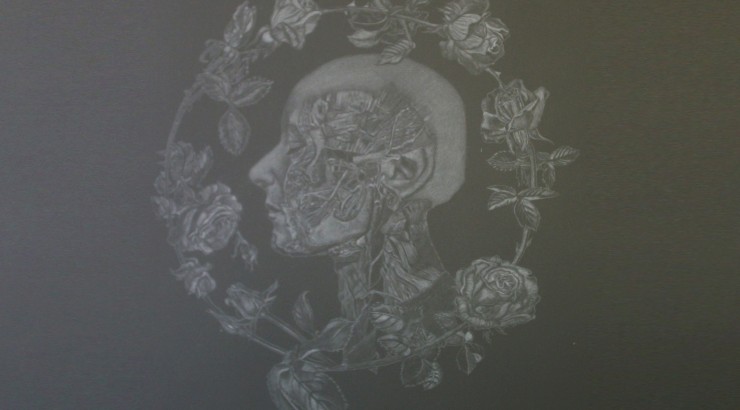Carole Caroompas’ Study for a Briar Rose Stop and spot the roses
March 21, 2016
Women’s History Month is here, which gives us the wonderful opportunity to talk about one of our many talented female artists, Carole Caroompas and her intriguing drawing, “Study for Briar Rose.”
Carole Caroompas was born in Oregon City, Oregon and currently lives and works in Los Angeles, California where she is a professor at Otis College of Art and Design. Caroompas received her M.F.A at the University of Southern California, Los Angeles in 1971 and her B.A at California State University, Fullerton in 1968. Caroompas has received numerous awards and grants for her work including the Otis College of Art and Design Development Grant (2013) and the Peter S. Reed Foundation Grant (2006) and has participated in group and solo exhibitions across the U.S.
Carole Caroompas often takes a rather conceptual approach to her art in order to explore narrative tropes and the inter-relationship of the sexes in society. Caroompas presents a feminist perspective of gender roles and analyzes sexism through the juxtaposition of imagery of her paintings. Carole Caroompas refers to her own art as “fragmented narratives [that] explore through psychological imagery the struggle, conflict, and vulnerability of male and female roles in a male dominant culture”.
Carole Caroompas’ Study for Briar Rose (1989) hangs on the Fourth Floor of Beckman and is a color pencil drawing on paper. The title “Study for Briar Rose” most likely refers to the Grimm’s fairytale story entitled “Briar Rose” which served as the basis for Disney’s “Sleeping Beauty” and “Maleficent” as well as numerous plays and ballets. The plot of “Briar Rose” by the Grimms Brothers is similar to that of the Disney rendition in that a princess touches a spindle, falls into a deep sleep, and is saved by the kiss of a prince. This literary connection explains why the figure in the drawing appears to be asleep and provides ample opportunity for feminist interpretation. The rather grotesque depiction of the insides of the figure’s skull is contrasted with the elegant and serene darkness that permeates the drawing. In this piece, Caroompas seems to be commenting on the typical “prince saves the helpless princess” narrative that is so quintessential of fairytales and confronting the iconic “and they lived happily ever after” ending.
Carole Caroompas was an established painter when she became interested in performance art and began to compliment her paintings with performances and songs. One of there most well known performances is entitled “Target” and is composed of a cycle of eight chant-like songs. In her performances, Caroompas would stand in front of a wall of diagrammatic photographs and text and sing along to a prerecorded soundtrack of Casio notes, metronomes and handclaps, found sounds, and tracks of her own voice. Each song began with the sounds of arrows hitting the target, one after another. Caroompas’ songs are loosely about relationships, desire, power, and modes of or lack of communication. In one of her tracks entitled “The Baby-Classic,” Caroompas confronts her disappointments as a woman, artist, and lover with the lyrics: “I had great expectations about almost everything (counting 1,2,3,4)/ And I had high ideals for almost anything (1,2,3,4)/ And I thought things could be perfect once you paid your dues (1,2,3,4)/ But most of all, I had great expectations about you (1,2,3,4).



